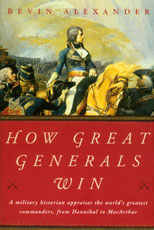 Click here to purchase from Barnes & Noble.
Click here to purchase from Amazon.com.
Click here to purchase from Barnes & Noble.
Click here to purchase from Amazon.com.
Following a "Plan with Branches"
Excerpt from How Great Generals Win, by Bevin Alexander, pages 303-04
Although an eighteenth-century French officer, Pierre de Bourcet, coined this phrase, Subedei Bahudur used the principle in 1241 in the Mongol invasion of Europe. One column of Mongol horsemen rushed westward into Poland and Germany north of the Carpathian Mountains, drawing off all forces in this region. Meanwhile, Subedei sent three columns toward Budapest, on the Danube River, one by a wide northern circuit, another through Transylvania to the south, and the third directly on the city. These widely separated penetrations kept Austrian and other forces from uniting with the Hungarians. Even if one column had been stopped, the others could have reached Budapest. The Mongols destroyed the now-unsupported Hungarian army a few days later. (See page 87.)
Napoleon, at the start of his Italian campaign in 1796, advanced several columns at wide points along the front, knowing that the enemy could not be at all places at once and that if one French column was blocked, the others could continue to seize key enemy positions. (See page 104.) Once the main resistance had been broken, Napoleon used a variation of the principle by sending three columns, each within a day’s march of the other, against the Piedmontese capital of Turin. Each column, like an octopus’s waving tentacle, could grip any opponent in its path, while the other columns could close up on it. This threat caused the Piedmontese government to capitulate (see page 106).
The Union General Sherman, after capturing Atlanta in 1864, advanced through Georgia in several columns. Confederate defenders did not know whether the columns were aiming at Augusta to the northeast or Macon to the southeast and divided their forces between them. Sherman burst between them and seized Savannah. When Sherman turned northward into South Carolina, the Confederates could not tell whether he was targeting Charleston or Augusta. Sherman went between both and captured Columbia, forcing the Rebels to abandon Augusta and Charleston. Again, the Confederates did not know whether Sherman was marching toward Charlotte or Wilmington, North Carolina. Instead he seized Fayetteville between the two, then marched on Goldsboro, having virtually eliminated the Confederate rear and forced the end of the war. (See page 159).
Early in 1935, the Chinese Communist army was being pressed front and rear by far superior Nationalist forces under Chiang Kai-shek in Guizhou province in south-central China. The Communist leader, Mao Zedong, ordered a column to feint directly west toward the Guizhou capital of Guiyang. This drew off the entire Nationalist force pressing on his rear. Mao then marched rapidly northeast, making Chiang believe he was planning to invade Hunan province and holding in place a huge Nationalist army on the Hunan border. Mao now turned northwest and struck for his real target, Zunyi, in northern Guizhou, which he seized almost without opposition. Although Mao was unable to set up a base at Zunyi or cross the upper Yangtze River into China’s western province of Sichuan as he had hoped, he had so distracted Chiang that Nationalist forces were unable to combine against Mao when he retraced his steps and marched into the southwestern province of Yunnan. (See page 201.)
<< More 'Rules of War' Excerpts << Back to top